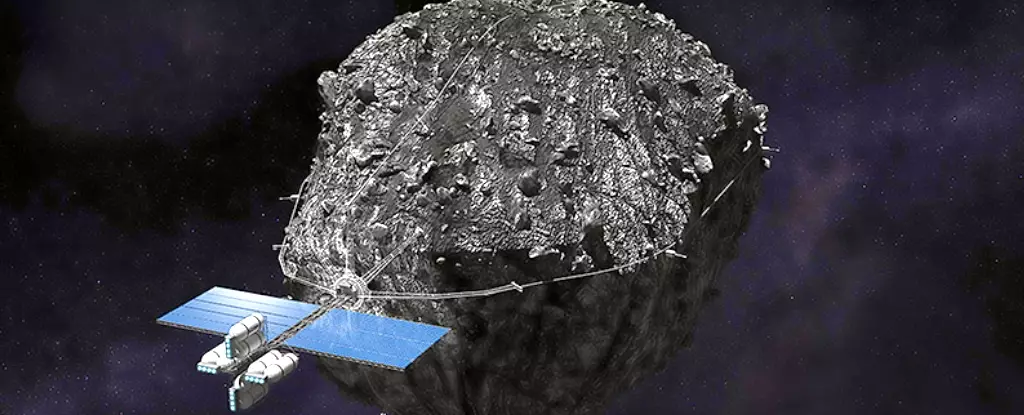The prospect of asteroid mining is often discussed with a sense of awe, punctuated by astronomical figures and grand ambitions. Articles abound touting the vast wealth embedded in these celestial bodies, particularly focusing on the metallic asteroid Psyche, which has been assigned a staggering valuation that stretches into the quintillions. However, the actual value of these resources and the feasibility of mining them are far more complex and nuanced than sensationalized headlines might suggest.
At the heart of the issue lies the astronomical valuations given to asteroids. A recent paper published through funding from Astroforge—a start-up aimed at pioneering the asteroid mining industry—sought to provide clarity. The research, conducted by a professor from Colorado School of Mines’ Space Resources Program, delves deeper than mere numerical projections. It systematically categorizes the metals found in asteroids into two segments: those worth retrieving for Earth and those valuable for in-space applications.
Platinum-group metals (PGMs), with their high economic value and essential roles in technology, emerge as the primary candidates for Earth-bound extraction due to their elevated prices and limited terrestrial availability. These elements are priceless in modern industries, earning their reputation as prime targets for theft on Earth, further underlining their value. Conversely, metals such as iron, aluminum, and magnesium, while abundant in space, are considerably less valuable when compared to their PGM counterparts. The dilemma arises when considering extracting these materials back to Earth; despite their usefulness in constructing structures in space, they wouldn’t warrant the high cost of transport from the asteroid belt amidst a market that already has a sufficient supply of these materials.
The concept of extracting pure metal asteroids has, until recently, been a popular narrative in the asteroid mining discourse. Challenging this assumption, the recent research indicates that such “pure” metal asteroids, once believed to be common, may indeed be mythical. Yet, asteroids often contain greater metal quantities than previous assessments suggested. Studies of meteorites, considered remnants of asteroids that have succumbed to Earth’s gravitational pull, provide compelling evidence of the profitability of asteroid mining. By comparing the elemental compositions of meteorites with terrestrial ores, researchers can better understand the economic viability of asteroid metal.
The study uncovered that, although PGMs are present in lower concentrations than initially estimated, they still exceed the amounts found in terrestrial ores. Particularly, refractory metal nuggets (RMNs)—tiny particles embedded in specific meteorite structures—have shown remarkable potential. These materials could yield exceptionally high concentrations of PGMs, significantly beyond what is practical to mine on Earth. With specific L-type asteroids possibly containing over 30% calcium aluminum inclusions (CAIs), one can imagine the immense rewards that await in these off-world treasure chests.
Despite the promising findings that underline asteroid potential, several challenges remain. Processing these extracted metals proves intricate, particularly when obtaining oxidized material and transforming it into usable metals. Sophisticated processes such as molten regolith electrolysis are necessary to liberate elemental metals, but they require substantial energy inputs. This brings forth the puzzling “chicken and egg” dilemma; the energy required to initiate large-scale mining operations may itself necessitate significant materials to construct an energy-generating system.
Ultimately, these impediments can only be overcome with dedicated innovations and sustainable space plans. Companies like Astroforge aim to inspire a shift toward space-based construction that could democratize access to these resources. Their forthcoming mission aims to rendezvous with near-Earth asteroids, potentially laying the groundwork for a better understanding of asteroids’ compositions and values, all while confronting the real challenges associated with economic viability and energy.
Looking ahead, it is imperative to bridge the gap between extravagant visions of mining asteroids and the realities of operational feasibility. While the metrics may present a tantalizing picture of wealth, the practical steps toward realizing these ambitions require rigorous scientific inquiry and technological advancements.
Asteroid mining holds transformative potential for humanity, not just in terms of resource acquisition but in building the foundation for future human activities beyond Earth. If companies like Astroforge can successfully navigate these hurdles, they may well usher in a new era of space industry. This endeavor will necessitate collaboration, innovation, and a multi-faceted understanding of both the resource potential of asteroids and the complex mechanisms that govern extraction and utilization. As we advance our exploration of the universe, the stories of asteroid riches will inevitably continue to inspire, but they must also be rooted firmly in scientific realism and prudent economic strategy.


Leave a Reply